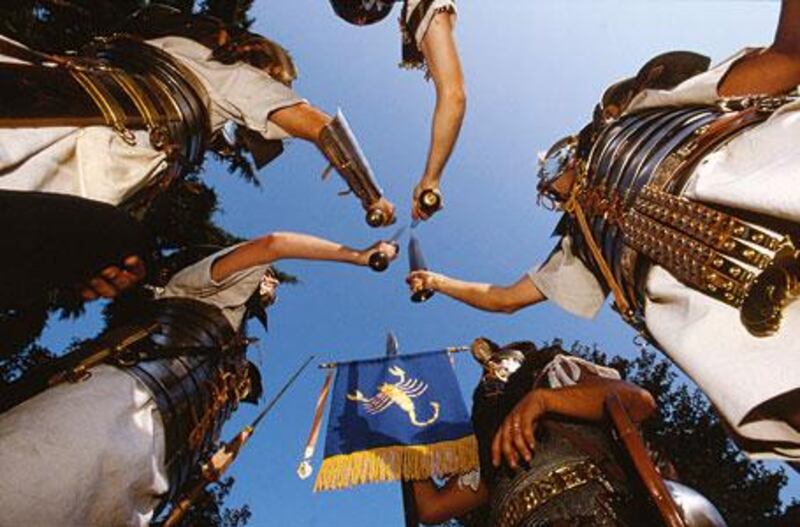For three days in September, Italians in Villadose recreate the sights and sounds of their ancient Roman ancestry through re-enactments. Marco Merola takes in the battles - and the glory - delivered with the same type of passion for which Italy is famous. A terrifying shout rings out, and spears and javelins shake with a mighty clatter. A wall of multicoloured shields rises as one, brandished by men in skirts and sandals. This is not the set of Mel Gibson's latest epic but a training session for Roman legionaries - probably one of the first since the empire fell 1,500 years ago. It is one of a series of historical re-enactments that take place over three days every September in Villadose, a small town in the Veneto region of north-eastern Italy.
According to the organisers, the "mercato della centuriazione Romana" (market for the training of Roman Legionaries) is more than just a jolly dressing-up session for history buffs; it is an attempt to spread the word about "experimental archaeology". All the costumes and events have a solid base in ancient texts and the most recent research. The aim is to recreate, as much as possible, the sights, sounds and smells of the Roman world.
On the days when the market takes place Villadose is transformed. The streets are filled with little stalls and tabernae (taverns), the modern signposts and traffic signs are carefully concealed with sacking and everyone - from the mayor to the tiniest child - strolls around in authentic Roman costumes, including the ancient Britons daubed with woad. There is much street theatre - plays, sporting events and impromptu gladiatorial contests. The key features however, is the parade of more than 200 people which proceeds through the town and the military demonstration given by the legionaries who are camped outside the centre. They spring into action when they are called to battle by the noisy hordes of Celtic savages, who threaten to invade the town.
The soldiers and barbarians are re-enactors - men and women with an incredible, almost manic, passion for antiquity. They think nothing of spending ?5,000 (Dh26,000) to get hold of the equipment they need. Italy might have been the heart of the Roman Empire, but Italians are mere babes in the world of re-enactment. The first people to have the idea of fashioning Roman armour were an English group known as the Ermine Street Guard, which formed in 1972. All over Europe there are dozens of re-enactment meetings every year with the most important taking place at Kirby Hall in Northamptonshire England, Tarragona in Spain, and Aalen in Germany. But the Italian events diary is sparse. There's not much for an Italian Roman soldier to do apart from being photographed with tourists outside the Colosseum and hoping for some work as an extra in a Hollywood movie.
"Until now re-enactment wasn't well thought of in Italy," says Enrico Maragno, the organiser of the event. "Most Italian people thought it was crazy to dress up in armour and pretend to be Romans. But I don't think we're crazy. On the contrary, we try to give emotions to the people, because everything we do is quite real. That's the right philosophy you should follow if you want to become a re-enactor. We don't claim that everything is 100 per cent accurate, we just try to create the same atmosphere. It's a good opportunity for museums, archaeological sites and so on to make history popular."
Villadose plays an important role in reclaiming Roman history for the Italians. Under helmets that have become red hot from the sun, the soldiers communicate in a mixture of languages; these Romans come from all over Italy as well as from Austria, Spain, France Croatia and Hungary. They've worked hard for this moment. As one warrior says: "I usually have a normal life, but sometimes I need to dress up in my armour and fight. We work hard before we take part in these battles. We have at least one training session per week. To be a good warrior you should have complete control of your movements, if you don't want to hit your friend. We just want to have fun, we don't want anyone go to the hospital."
Walking across the little river which flows though Villadose, it's a little disconcerting to hear the roar of a crowd shouting "Death! Death!" This is merely the coup de grace for the gladiators of the Familia Pannonica from Hungary, a team of 25 young re-enactors, as they exit defeated from the combat. The authenticity is not taken as far as actually slaughtering the fighters. At the end of three days, participants and spectators enjoy a final dinner. Refreshments are prepared in the tradition of the Roman convivium, of course, and everyone has the opportunity to try tasty dishes prepared from ancient recipes and washed down with plenty of mulsum (wine and honey) served by beautiful but haughty maidservants.





